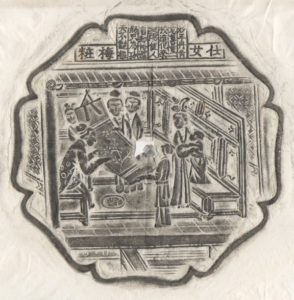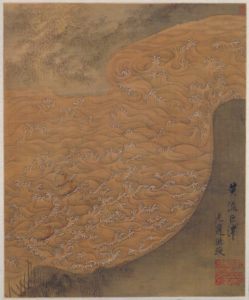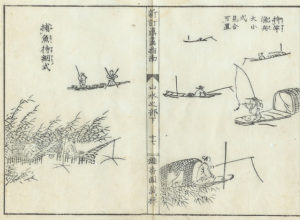This is an image from the back of a Song dynasty mirror in the collection of Martin J. Powers. As he describes it
One [woman], on the right, tends a child and sports an extremely elaborate coiffure. The larger woman on the left displays a plum painting she has completed and, pointing to it, appears to be explaining the fine points to the other women. Her hair is bound in a simple bun, and she wears a robe with a plum blossom design on it. Not all characters in the inscription above are readable, but the opening lines praise her artistic creativity, while the last two lines clearly read “She finds no charm in makeup; she lives for accomplishment alone,” pg.365
This is a wonderful image to use it you want to talk about women and culture, or culture and commerce (she may be selling it). The book it is in is Martin J. Powers, Katherine R. Tsiang, and Dana Arnold eds. A Companion to Chinese Art. Hoboken, NJ: John Wiley & Sons, 2015. The Kindle edition is $ 130, so you will probably have to get it through your university library or sell a kidney This is a fantastic resource for anyone who occasionally has to answer questions about Chinese art but does not actually know much about it. It is part of a series of Companions to the art of various cultures. This one has a great collection of contributors, so if you ever need a short history of landscape painting, or to sound knowledgeable when a student asks you why Chinese paintings always have writing on them, or wants you to explain calligraphy… this is your book.
It has all sorts of cool quotes and pictures you can use. Need a picture of the West Lake to talk about commercialized culture? 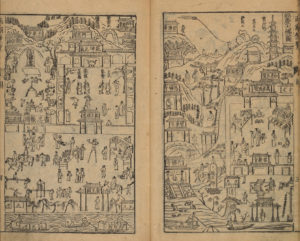
Need an image of Chen Hongshou’s Great Ford on the Yellow River?
Of course you don’t. Nobody -needs- that, but it is nice to have.
I was mostly browsing around looking for stuff on the role of art in defining the Late Imperial elite. I already had pictures from painting manuals.
Now I also have a page on “how not to paint bamboo”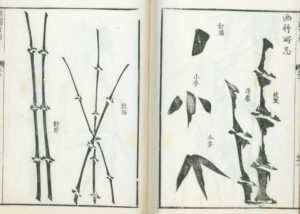
There is all sorts of stuff in here about the amateur ideal, gardens, the role of the court, commercialization, collecting, obsession etc.
A comment by He Liangjun (1506–1573) vividly conveys the rhetoric of leading intellectuals of the day. Among the public, there are people who become art lovers. They are told that [respected] families of the past collected paintings, so they follow [the trend] and purchase dozens of paintings [to display] throughout their houses, including in guest rooms and living areas, in order to prove their esthetic awareness. Those folks called “art lovers” nowadays are all such people. Only very few among them can tell the difference between an original and a fake, or know that mountain peaks [in paintings] show varying heights and mass, or that trees and branches should be smooth, or that rocks have three faces, that roads should be revealed gradually, that a stone’s surface shows veins, or that coloring has gradations and the illusion (of depth). Those who know these things count less than four or five out of a thousand. Those people with less learning are trying to follow the tradition; yet very few maintain a pure intention and spirit. Alas, within an area of one hundred miles, I haven’t seen even one [true artlover]. (He Liangjun 1569p.85
And, to get back to the picture at the top, these true artlovers could be women.
Looking at this Shanyang woman’s big style script,
you see a different kind of woman from those who dress up their hair. Leading proponent of the Cai Xiang style,her silkworm dots are superb, like her Yan style script.
Exploring hemp paper’s touch, smooth and silky like moss,
powerful black dragons beneath an autumn pond.
Or
On spotless desk, deep in her chamber, exploring with brush and ink; Her hair is white, but a hundred pounds of force moves in her wrist. Flourishing branches, withered twigs, each is as it is. Hang it in a great hall; the wind would shake the walls! pp.364
“exploring” corresponds to the literati notion of art production as a kind of
play; she doesn’t have a specific task to do for someone else, but paints for her own enjoyment, as Powers points out. Art for Art’s sake! In the introduction he talks about a lot of the Orientalist art criticism that used to be pretty common. Chinese art is dominated by the court and the the emperor’s taste (No, although he does have a quote from Fairbank to that effect. JKF’s tendency to make broad statements of the conventional wisdom of the time makes him helpful for books like this) Chinese artists were craftsmen, tied to tradition and lacking creativity (No). Of course part of this Art for exploration stuff is social posturing and dividing yourself from the craftsmen, but I think if you want to make the Early Modern elite look as Modern as possible this sort of thing would help.
I found the book to be tremendously enjoyable because it explained clearly a bunch of things I half remembered from grad school or that a lot of work has been done on since then.
